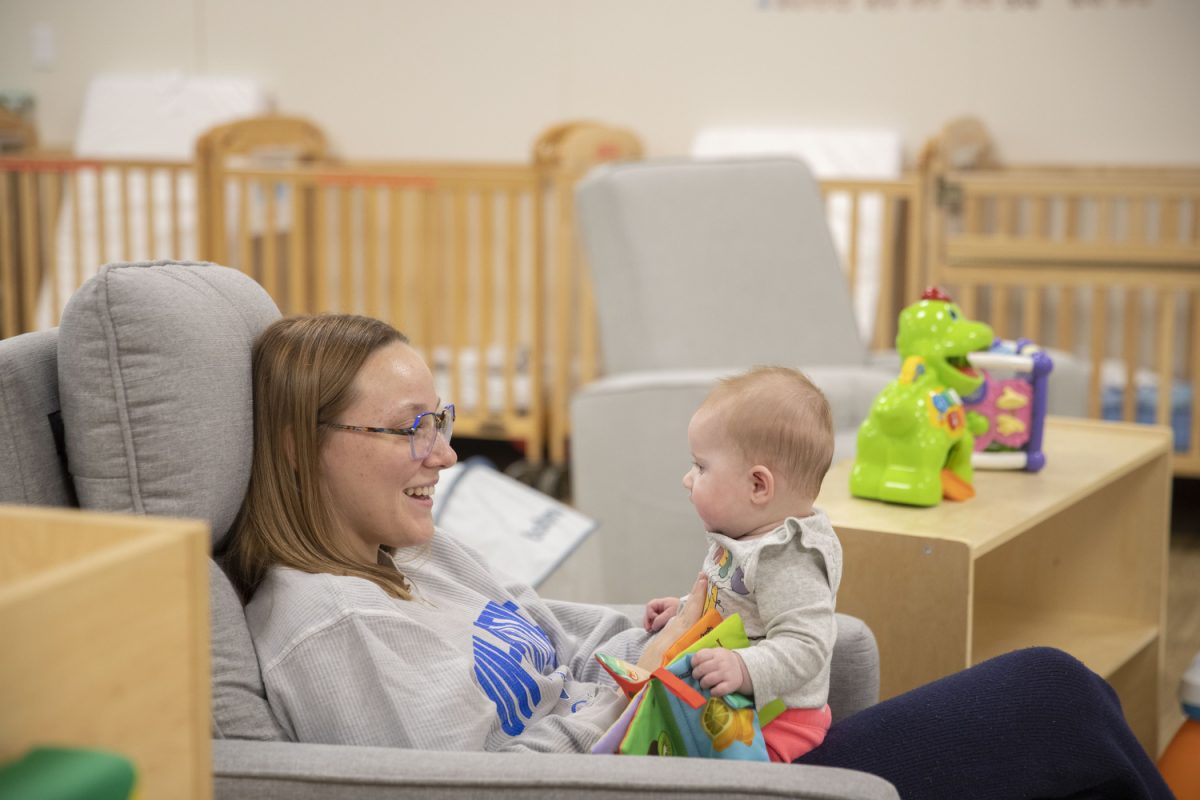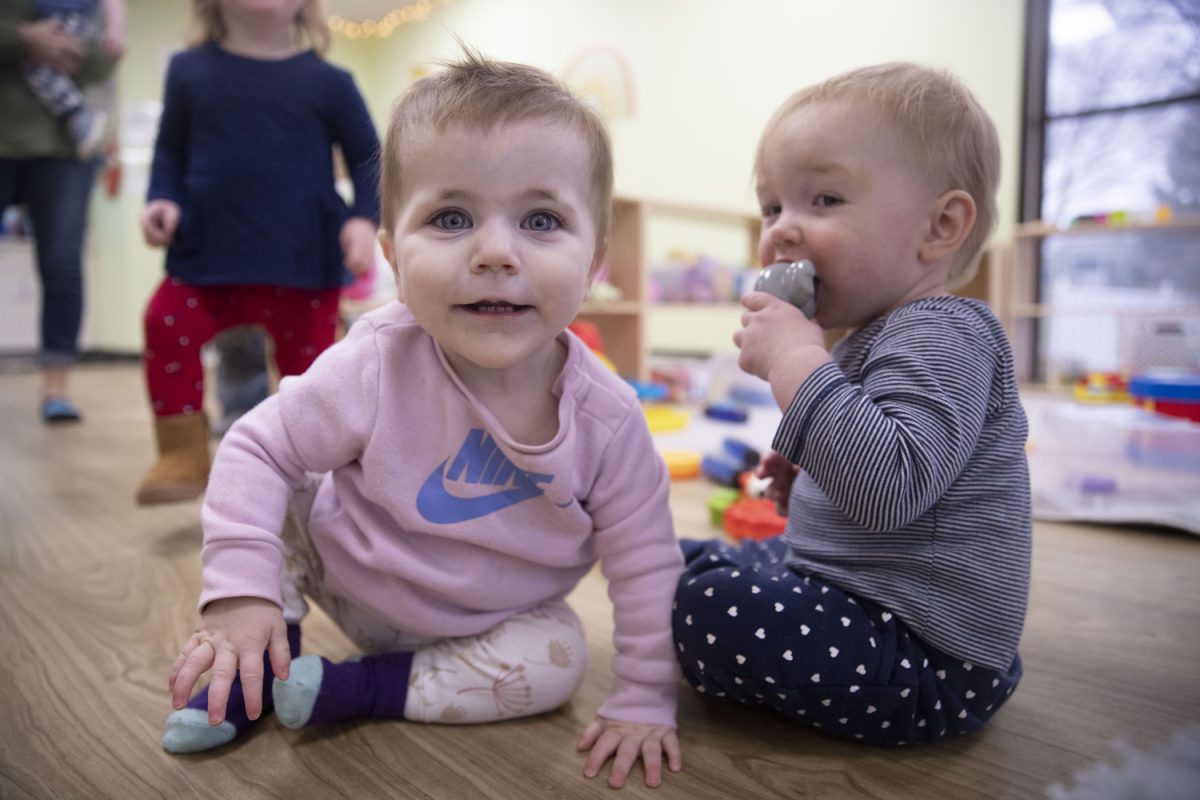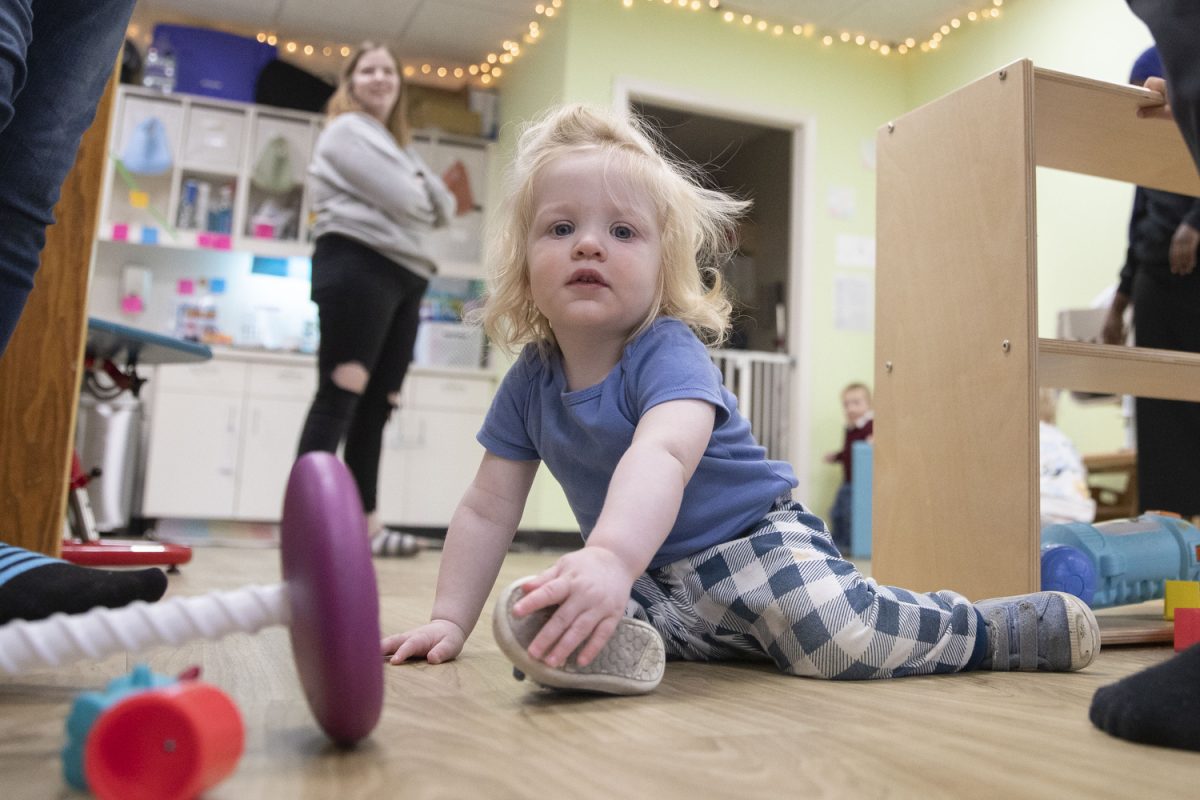As pandemic-era federal investments in child care expire, providers across Iowa and the U.S. are left to fill the growing gap in funding. Lawmakers are exploring bipartisan efforts to help struggling families in Iowa, but haven’t reached a consensus on how best to address the “child care cliff.”
The funding that came with the 2021 American Rescue Plan Act, a $1.9 trillion federal stimulus package, ended Sept. 30. The funds helped supplement staff wages, child care center renovations, and expand available child care enrollment.
The emergency funding provided by the American Rescue Plan Act staved off a collapse of the childcare industry that was struggling to stay afloat before the global pandemic. Now, the industry faces an uncertain future while policymakers ponder more investments in child care.
According to a report from the Annie E. Casey Foundation, 14 percent of families who had children aged 5 and younger had a member who quit, changed, or refused a job because of problems with child care, compared with 13 percent nationwide in 2021.
Nearly $24 billion was allocated to stabilize the national child care industry around the country during the COVID-19 pandemic through the federal relief package. The funds helped 220,000 providers and impacted 9.6 million children, according to the U.S. Department of Health and Human Services. The average award for child care centers was $140,600.
Iowa received $200 million in federal funding for child care under the American Rescue Plan Act, which was distributed to 2,155 child care providers across the state, according to an HHS report.
This leaves child care providers and state and local governments to fill the gap now that funds have dried up. According to a June report by the Century Foundation, a progressive think tank, the gap could threaten access for over 13,000 Iowa children, and 401 child care programs in the state could close due to the funding cliff.
That report also found that more than 3.2 million children and 70,000 programs nationwide could be impacted by the expiration of this funding.
States like Iowa have invested their own money, in addition to federal funds, into child care in the state. Iowa Gov. Kim Reynolds recently announced a third round of child care business incentive grants in October. The grants are part of over $500 million that the state of Iowa has spent on child care since 2020, according to the governor’s office.
The Arc of Southeast Iowa, located in Iowa City, received $274,350 to renovate and expand its daycare center to increase overall capacity. The grant helped the center increase its physical capacity from 30 to 70, but because of staffing challenges, the center has only been able to increase overall enrollment by 17 children.

Jenny Winegarden, the program director at the Arc of Southeast Iowa’s child care center in Iowa City, said the center hasn’t filled all of its slots because of the delicate balance the center must navigate. To bring in more children, the center needs more staff but must enroll more children to pay the staff.
This is because child care centers usually make all their revenue from child care tuition, making it difficult to hire more employees without guaranteed enrollment to subsidize more staff, Winegarden said.
Mary Janssen, the director of the northwest region for the Iowa Child Care Resource and Referral, said tight budgets plague many child care providers’ ability to offer higher wages. Janssen said this is due to all revenue, besides grants, coming from tuition.
“The only cost increase that our child care providers can do will be right back to that parent in the form of a fee increase,” Janssen said. “It’s really not an easy thing for them to do because ultimately they could lose that family down the street to someone that is charging less.”
Winegarden also said low wages make it difficult to attract and retain providers.
“We’re now living in a world where people can go to McDonald’s and make $15, $16 an hour and as a nonprofit agency, that’s just not something that we can afford,” Winegarden said.
Low wages, slow recovery for child care workforce
According to the report from the Century Foundation, 3,536 Iowa child care jobs and more than 232,000 child care jobs nationwide could be lost due to the funding cliff. This leaves providers in the lurch as local officials decide how to fill the gap.
The sector is already slow to recover; the child care sector has 3.7 percent fewer jobs than before the pandemic, according to data from the Bureau of Labor Statistics.
The child care sector also has some of the lowest-paying jobs. In Iowa, the median wage for a child care worker is $10.99, while a cashier’s median wage is $13.03 in the state, according to May 2022 data from the Bureau of Labor Statistics.
Nationally, child care workers earn a median wage of $13.71, while cashiers earn $13.58 nationally, according to May 2022 data from the Bureau of Labor Statistics.
The Johnson County Board of Supervisors allocated funding from its share of ARPA funds to increase wages for local child care workers.
The program provides a $2 wage increase to child care workers at centers that receive grant funding. The county will also provide $0.153 per $2 to cover additional payroll taxes paid by the employer.
Sheila Hansen, a senior policy advocate at Common Good Iowa, a nonprofit advocacy organization that advocates for child well-being, said providers across the state are having trouble keeping workers due to low wages, leaving providers without the ability to expand their capacity.
“We are still seeing places that can’t hire anybody because they can’t pay a wage that is a living wage, so providers are choosing to work elsewhere,” Hansen said.
Hansen said federal child care assistance reimbursement rates are also an issue that providers face, with the rate of reimbursement for aid not covering private pay tuition rates.
Some say child care not optimal for providers
Child care assistance to low-income families has helped provide access to child care for the 17,680 children currently enrolled in the state’s child care assistance program.
Child care tuition rivals that of public universities in Iowa at $10,437, according to a 2023 report by the Annie E. Casey Foundation, a nonprofit that focuses on child well-being.
Record high costs leave Iowans looking to the state and federal governments for assistance.
Under a new Iowa law signed in May, the income requirements for state child care assistance would go from 145 percent of the federal poverty level to 165 percent. A fiscal analysis by the nonpartisan Legislative Services Agency found the law would likely increase enrollment by 1,756 children, allowing a total of 19,436 children to receive federal child care assistance.
The bill invests an additional $20 million in child care in Iowa annually, according to the agency’s fiscal analysis.

Child care tuition rivals that of public universities in Iowa at $10,437, according to a 2023 report by the Annie E. Casey Foundation, a nonprofit that focuses on child well-being.
Record high costs leave Iowans looking to the state and federal governments for assistance.
Chelsey Markle, the executive director of the Arc of Southeast Iowa, said child care assistance reimbursement is not enough to cover tuition costs and that it disincentivizes providers from accepting child care assistance.
Hansen said the state also does not reimburse enough absent days for children who receive child care assistance. Under the state’s program, only six absences are reimbursed to providers. After the sixth absence, they are not paid for those absence days.
“Sometimes families who are low income and qualify for child care assistance might be gone more than six days a year,” Hansen said. “And so what happens is that on the seventh, eighth, ninth day, those providers have that spot open, but they get no pay for it.”
Federal child care grants in the works
ARPA provided an additional $15 billion to expand the Child Care and Development Block Grant, which helps low-income families pay for child care. That funding is set to expire at the end of September 2024.
The state’s program is funded through the federal Child Care and Development Fund under the federal Child Care and Development Block Grant.
President Joe Biden’s administration recently introduced a bill to infuse $16 billion into the block grant. After being reintroduced on Nov. 2 by U.S. Sen. Patty Murray, D-Wash., the chair of the Senate Appropriations Committee, but the bill has still not left the Senate Committee on Health, Education, Labor and Pensions.
The bill would give $153 million in funding to child care in Iowa if Biden’s proposal, in partnership with Murray and other Democratic colleagues, were to pass without alteration.
The Biden administration has also proposed capping co-pays for child care assistance at 7 percent and waiving them for families under 150 percent of the federal poverty level.
“Without support, our child care providers are staring down some very impossible decisions — laying off staff, cutting child care slots, raising prices for families, or just simply shutting their doors because they have no other choice,” Murray stated in a Nov. 2 news release. “So this is a huge problem for working parents. They are already struggling and they are going to be pushed out of the workforce if we don’t have these child care stabilization funds.”

However, no Republicans have signed onto the bill and Republicans in the House of Representatives have offered an appropriations bill allocating half the amount proposed by the Biden administration for child care block grants.
Congress continues to be divided over government funding over Republicans’ concerns about federal spending and national debt. U.S. Sen. Joni Ernst, R-Iowa, has publicly supported bipartisan measures to expand child care. In March, Ernst supported a bipartisan bill allowing the small business administration to grant funding to religious nonprofits for child care grants.
Ernst also supported a measure to expand funding for rural child care in June.
U.S. Rep. Ashley Hinson, R-Iowa, has advocated for other types of child care funding in the House.
Hinson introduced the Child Care After Hours Act that would provide block grant funding to child care centers that have hours outside of normal day shift hours.
The grant allows centers that provide at least 25 percent of their hours outside traditional work hours or on the weekends.
Hinson said this will help parents who work overnight or evening shifts and struggle to find child
care options.
Hinson also supported $8 billion in funding for childcare grants in the Labor, Health and Human Services, and Education appropriations bill for fiscal 2024. Hinson also co-chairs the bipartisan Pre-K and Child Care Caucus.
“This is even harder for parents who don’t work traditional 9-5 hours, like law enforcement officers, store clerks, emergency service operators and nurses,” Hinson said in a May 25 news release. “Their jobs are critical to the health and safety of our communities – we have to make it easier for these hardworking Iowans to stay in the workforce while raising a family.”
However, the majority of measures supported by the senators remain in committee processes and have yet to make it to a vote on the floor.



